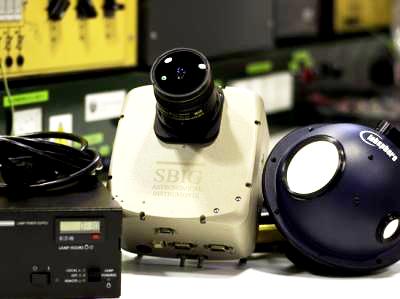Tag archives: Spain
Eyeing light pollution
By Tushna Commissariat

The newly patented all-sky camera (Courtesy: University of Granada)
Researchers in Spain have developed a small and light device that can quickly and accurately measure the light-pollution levels or artificial night-sky background brightness for a given location. The team, led by Ovidio Rabaza from the Department of Civil Engineering at the University of Granada, has developed a portable system that includes an all-sky camera and several interference filters that can be easily transported and can be used anywhere.
Currently, methods to measure light pollution that affects the night sky involve using complex techniques such as astronomical photometry, which requires large-scale and expensive equipment generally housed in observatories, according to the researchers. According to the team, the new system is “clearly innovative because, for the first time, relative irradiance and sky background luminance have been measured through wide-field images, of all the sky, instead of using more conventional methods”.
View all posts by this author | View this author's profile
Starry Starry Night
By Tushna Commissariat
It is commonly thought that astronomy and astrophotography are rather exclusive hobbies and that you require a lot of specialist equipment and training to pursue them. But an amateur astrophotographer, using only his ordinary digital SLR camera, a tripod and his love for the skies, has won the major astrophotography prize at the inaugural STARMUS festival.
Not only did Alex Cherney win the opportunity to attend and mingle with the who’s who of astronomy at the STARMUS festival – an astronomy and space-science festival held in the Canary Islands this June – but the Australian amateur astronomer also won an hour using one of the largest optical telescope on the planet – the 10.4 m Gran Telescopio Canarias (GranTeCan), in the Canary Islands in Spain.
Cherney’s prize-winning collection of time-lapse sequences of the Milky Way, seen over the Southern Ocean, beat a bevy of global participants for the best entry as judges felt his scenes were “chosen with the eye of an artist” and that his “subtle panning and excellent control of colour and contrast revealed technical skills of the highest order”. Cherney uses only his Nikon D700 DSLR camera and produced a compilation of images taken over 31 hours of exposure time.
This is notably the first time an amateur astronomer has been allowed access to the GranTeCan and Cherney was keen to make the most of the opportunity. After much deliberation, he decided to use his hour to observe and photograph Arp84, a pair of interacting galaxies – NGC5394 and NGC5395. (Image above courtesy: Alex Cherney)
“I wanted an object that would look nice given the parameters of the telescope and has not been photographed in colour and great detail by a professional telescope,” he said. Noel Carboni, an astro-image-processing expert, met Cherney at the festival and helped to produce a colour image. Carboni feels this is the clearest image of Arp84 ever made. Cherney felt the experience of using the telescope was “incredible”, akin to taking a space flight. “It is very hard to describe what it is like to observe space with an instrument that is helping scientists seek answers to the origin of the universe.”
Cherney put his opportunity of being at the La Palma observatory to good use, producing another time-lapse video featuring GranTeCan and MAGIC (Major Atmospheric Gamma-ray Imaging Cherenkov Telescopes) as the backdrop for the night skies. Take a look at the stunning video below.
Outer Space from Alex Cherney on Vimeo.
View all posts by this author | View this author's profile
